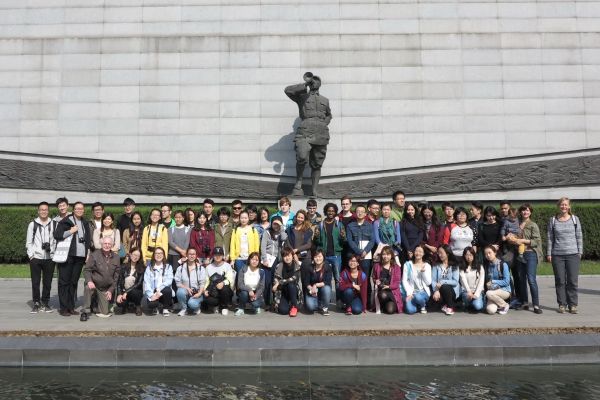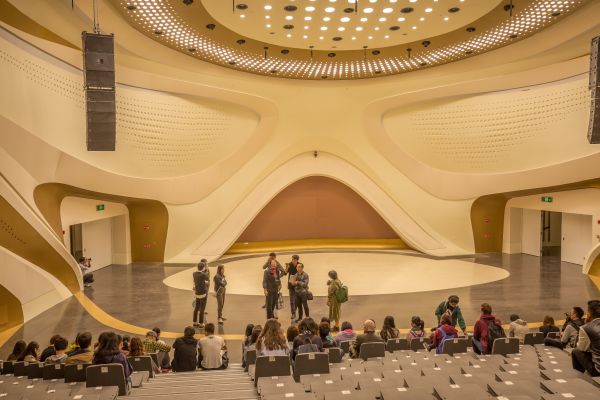20 Nov 2015
For Year Three students from the Department of Architecture the recent reading week became an interesting five-day study trip to Nanjing.
The group of 52 students, which included a number of exchange students from the University of Liverpool, was joined by four members of academic staff and was led by Dr Yiping Dong.

The trip was designed to give the students a unique educational experience by providing opportunities to visit historic buildings as well as more recent modern, contemporary architecture and urban design by both Chinese and international architects.
The trip started on Monday 26 October with the group visiting the famous Qixia temple, a Buddhist monastery founded in 489 AD. The first day also included visits to Jimin temple, founded nearly 1,500 years ago and which sits atop Jilong Hill just outside the city walls, and a tour of the City Wall Museum where students discovered the history and extent of the remains of the historic walls. The day ended at Ganxi Mansion, which dates from the 19th century and is the biggest and best-preserved private mansion in Nanjing.
The students were divided into 13 groups with each group carrying out research of a particular building or site before the trip and then presenting their findings to the whole group at each location.

Day two started with an early morning visit to the Nanjing Massacre Memorial Hall and Gardens, opened in 2011 to commemorate the citizens of Nanjing who were killed in 1937. The early afternoon was spent in the Presidential Palace before a trip to the Jiangning Imperial Silk Manufacturing Museum, which was designed by the well-known architect and academic Wu Liangyong and opened in 2009. After dinner the group visited the architecture department of the South East University and attended a lecture on Nanjing architecture by Professor Wang Xiaoqian.
Located in the Drum Tower district of the city, Yihe Road is famous for the mansions built there in the Republic of China period (1912 – 1949). The students started day three examining these elegant buildings, many of which are now converted into hotel accommodation. This was followed by a lecture on the history and development of the campus of Nanjing University given by Professor Leng Tian.

During the afternoon, the group drove to the Nanjing Sifang Art Museum site, located in a forest outside the city, where award-winning Chinese and international architects, including Wang Shu, Ai Weiwei and Steven Hall, have designed a number of private villas as well as hotels, a conference centre and the Sifang Art Museum. Here the students were able to appreciate and study the different design approaches of these famous contemporary architects. The day finished with a visit to the old East Historic District where the students visited the magnificent Zhonghua City Gate, known as the “Gate of China”, and the Imperial Examination Museum in the Fuzi temple area, which dates from the Song Dynasty.
The next day, Thursday, saw a visit to the Ming Palace ruins followed by a guided tour of Nanjing Museum, which is one of the largest in China. The original building was built in 1948 in Liao Dynasty style. A significant extension in a more modern but restrained style was completed in 2013.

The students spent the afternoon on Purple Mountain visiting and exploring the tombs and spirit path of Mingxiao Mausoleum, where the Mausoleum of Sun Yat-Sen can be reached at the top of a 395-step hill. Sun Yat-Sen is revered as the founder of new China and his memorial was the result of an international design competition won by Lu Yanzhi. The newly-refurbished Meiling Residence where former president of China Chiang Kai Shek lived in the 1930’s is also located on the mountain. Finally the students visited, in fading light, the ancient Linggu Temple, and the more recent pagoda built in 1929 as a memorial to the soldiers who lost their lives in the Northern Expedition in 1928.

The last and final day began with a visit to do some sketching at the Chaotian Gong Palace. The International Youth Cultural Centre, designed by Zaha Hadid, was built for the 2014 Youth Olympics in China. Here the students spent several hours exploring the curved forms of the stunning modern building by one of the world’s best-known architects.

On the way back to Suzhou, on Friday 30 October, the group stopped in Wuxi for a guided tour of the historic Jichang Garden, dating from the Ming Dynasty and known as the Qin family garden.
Tutors who accompanied the students were Yiping Dong, Aleksandra Raonic, Ganna Andrianova, Quanqing Lu and Edward Farrell.
Photography; Milan Ognjanovic, others by Yiping Dong and Edward Farrell
20 Nov 2015







